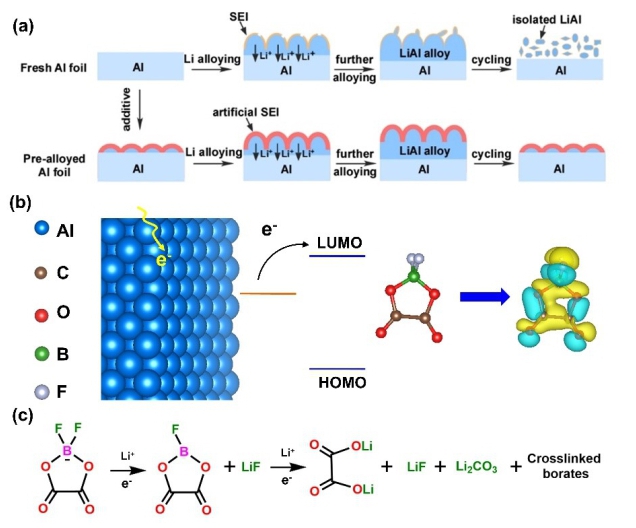Scientists Propose Novel Pre-alloyed Aluminum Alloy-Type Anode Energy Storage Devices
Date:15-04-2020 | 【Print】 【close】
Conventional batteries incorporate two electrodes – an anode and a cathode, anode materials like Si, aluminum (Al), Sn, etc., are promising candidates of replacing traditional graphite.
However, the cycling stability of these alloy-type anode materials is still found to be unsatisfactory, since their huge volume expansion when lithiated (Si: ~300%; Al: ~97%; Sn: ~260%), which causes the solid electrolyte interface (SEI) damage, and eventually the pulverization of electrode materials.
A research group led by Prof. TANG Yongbing and his team members (Dr. OU Xuewu, Zhang Ge, etc.) from the Shenzhen Institutes of Advanced Technology (SIAT) of the Chinese Academy of Sciences proposed a novel strategy by combining the pre-alloying and artificial SEI together to enhance the cycling stability of Al anode.
The purpose of the pre-alloying treatment was to compensate for the irreversible loss of Li+ and the formation of dead Li, while the artificial SEI originated from the reduction of electrolyte additive contributed to enhancing the structural stability of the anode.
After investigating the matching behaviors of several additives with different anodes, lithium difluoro (oxalate) borate (LiDFOB) was chosen as the optimal additive since its oxalato-borate structure can be reduced and polymerized via the ring-opening reaction at the anode side, and the fluorine atoms in LiDFOB were useful to form artificial SEI and produced lithium fluoride (LiF)-rich component, giving improved stability to SEI.
Researchers have constructed Li hybrid capacitor (LHC) by combining the achieved pre-alloyed Al-LiDFOB anode (so as the current collector) and environmental friendly activated carbon cathode.
The LHC exhibited a specific capacity of 123.6 mAh g-1 with a capacity retention of 85.6% after 2000 cycles. The study showed potential applications for high-performance energy storage devices, and was published in Energy Storage Materials.

Figure. (a) Proposed mechanism of simultaneous pre-alloying and artificial SEI strategy to improve the cycling stability of Al anode. (b) The reduction schematics of DFOB- at Al anode and the differential charge density of DFOB- after accepting an electron. (c) The reduction and polymerization reactions of DFOB- via the ring-opening reaction. (Image by Dr. OU Xuewu)
Media Contact:
ZHANG Xiaomin
Email: xm.zhang@siat.ac.cn